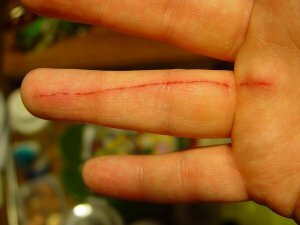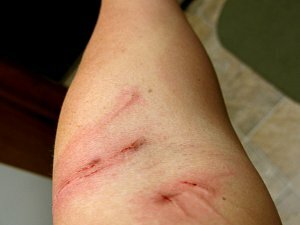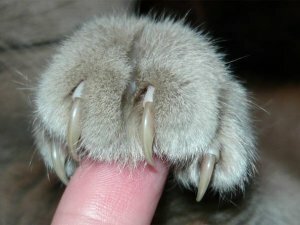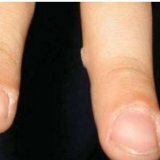Felinosis( cat scratch disease)

Description
Felinosis is an acute infectious disease that occurs after scratching or biting a cat. Dogs are very rare sources of infection. It flows with the formation of a nasal papule( nodule).In the future, regional( local) benign lymphadenitis may develop.
The causative agent is found in the microflora of the oral cavity of the animal. Therefore, cats themselves are not affected by the disease. From an animal to an animal, the infection is transmitted only through fleas. Felinosis is a zoonotic. Disease from person to person does not pass. Only the animal transmits the disease.
The disease is usually observed in the winter. Infections are inflicted on children and men. Women fall ill with felinosis very rarely. Damage is usually localized in the neck, face and hands.
There are 2 forms of percolation of felinosis: typical and atypical. Each has its own symptoms.
Typical form of
For this form there are 3 periods of the disease:
- The initial( up to 3 days) is accompanied by the appearance of itching and rash.
- The period of the height of the illness( from 1 to 3 weeks) is accompanied by the appearance of papules and enlarged lymph nodes in the inguinal or axillary region.
- The final stage( recovery).The patient's condition is stabilized, the lymph nodes take a normal size.
Atypical form of
With this form, the infection does not fall on the skin. It can be the mucous membrane of the eye. There will be redness and swelling of the eyes. There will be painful sensations, parotid and submandibular nodes become inflamed.
The nervous system may be affected. Atypical form rarely develops into endocarditis( inflammation of the inner shell of the heart), pleurisy, osteomyelitis and erythema nodosum.
Causes of
 Bartonella is the main causative agent of the disease. The cause of the disease is the penetration of the pathogen into the blood. This can happen through the damaged skin, the mucous membrane of the eyeballs. An inflammatory process develops in the form of primary affect.
Bartonella is the main causative agent of the disease. The cause of the disease is the penetration of the pathogen into the blood. This can happen through the damaged skin, the mucous membrane of the eyeballs. An inflammatory process develops in the form of primary affect.
Further on the lymphatic vessels the pathogen passes into the regional lymph nodes, lymphadenitis develops. Gradually, other lymph nodes, liver, heart muscle, central nervous system are involved in the pathological process.
Symptoms of
Chlamydia, causing the disease, accumulate in the lymph nodes, which begin to increase, there is soreness when palpating.
Signs indicative of infection in the bloodstream are as follows:
- swelling and redness in the bite zone;
- of the appearance of papules that excrete pus;
- development of the inflammatory process;
- appearance of fistulas, granulomas, necrosis in the area of scratches;
- intoxication of the whole organism;
- fever;
- increased fatigue;
- headache;
- decreased appetite;
- sore throat;
- infection of internal organs with weakened immunity.
Duration of the incubation period from 3 days to 2 weeks.
Diagnostics
Diagnostic studies that identify diseases in children and adults are as follows:
- Lymph node biopsy.
- Microbiological analysis.
- General analysis of urine.
- The general or common analysis of a blood( rising of an ESR speaks about an inflammation).
- Serological method of diagnosis( detection of antibodies to the pathogen).
- PCR - diagnosis( detection of bacteria and viruses in the blood).
Treatment of
 The mild form of the disease usually does not lead to complication. The disease can be treated with medications. Doctors prescribe indomethacin, diclofenac, ibuprofen, cetrine and others. In addition, antihistamines, vitamin complexes are prescribed. Patients are treated on an outpatient basis.
The mild form of the disease usually does not lead to complication. The disease can be treated with medications. Doctors prescribe indomethacin, diclofenac, ibuprofen, cetrine and others. In addition, antihistamines, vitamin complexes are prescribed. Patients are treated on an outpatient basis.
A heavy form of felinosis needs surgery. The surgeon opens the granulomas, removes the purulent discharge and cleans the damaged tissue.
Hospitalization is required only when the complication of the disease develops. This is a lining of the lymph nodes with the development of ulcers, fistulas, with myocarditis, abscess of the spleen, polyneuritis, meningitis. If any secondary infection has been identified or problems have arisen in the diagnosis.
The patient is recommended bed rest, diet and copious drink. If necessary, physiotherapy sessions( diathermy and UHF) are prescribed.
What increases the chance of a complicated course of felinosis?
A severe or atypical form of felinosis develops with:
- diabetes mellitus;
- alcohol abuse;
- HIV-infected patients;
- after surgery or severe illness;
- rheumatoid arthritis;
- of psoriasis.
Folk remedies
 Folk remedies for the treatment of scratches are not required. If the cat has bitten or scratched, then the damaged skin should be treated with special ointments or solutions that have disinfectant properties.
Folk remedies for the treatment of scratches are not required. If the cat has bitten or scratched, then the damaged skin should be treated with special ointments or solutions that have disinfectant properties.
On the inflamed area of the skin it is recommended to apply compresses from 1 part of dimethylsulfoxide and 4 parts of water. Moistened with a solution of gauze to put on the lymph node, close the top with polyethylene and fix it with a bandage. Wear a bandage with a cloth.
Complications of
Prognosis of treatment is always favorable. Complications are very rare. Serous meningitis, arthritis, pleurisy, encephalomyelitis, or encephalitis may occur.
Also, bacteria cause changes in blood: the number of platelets, white blood cells and platelets decreases. After recovery in the human body, life-long immunity is produced.
Prevention of
No specific prophylaxis has been developed. For prevention it is recommended to minimize contact with animals. The places of bites and scratches need to be disinfected with hydrogen peroxide.
Scratches and bites should be washed immediately with running water and soap and treated with alcohol.



